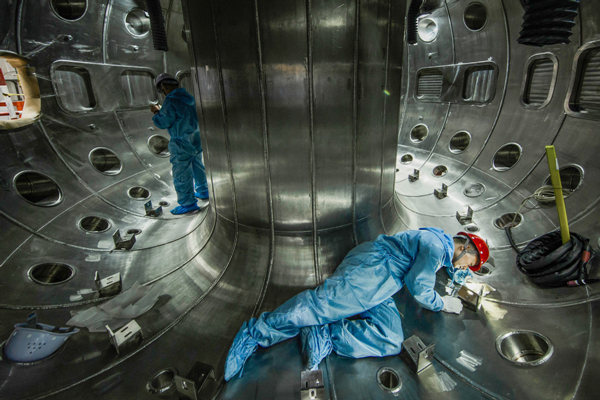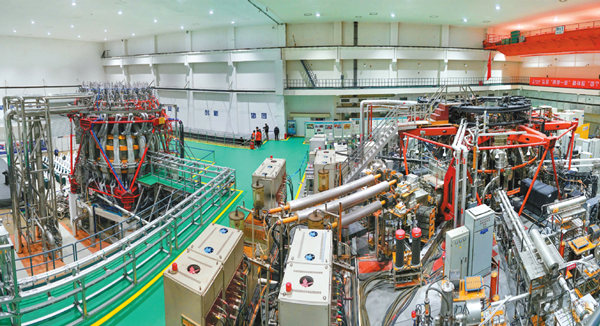
Employees from China National Nuclear Corp's Southwestern Institute of Physics install experimental research equipment at a nuclear facility in Chengdu, Sichuan province on Sept 16, 2019. [Photo/Xinhua]
Nuclear power to play key role in China's clean energy plans
China's "artificial sun" -a nuclear fusion reactor that mimics the activity taking place within our nearest star-could help the country reach its target of producing fusion energy for commercial use by 2050, insiders said.
The new-generation HL-2M Tokamak began operating in December in Chengdu, Sichuan province. It has since achieved its first plasma discharge, said China National Nuclear Corp.
Designed to replicate inner sun reactions using hydrogen and deuterium gases as fuel, the apparatus will provide clean energy through controlled nuclear fusion and is expected to greatly enhance the research and development of key technologies in plasma physics research in China, CNNC said.
China plans to build an experimental reactor as early as this year and an industrial prototype by 2035, and allow it to enter large-scale commercial use by 2050, according to its fusion technology development plan.
Analysts said that as China turns on its artificial sun, this proves that relevant authorities have mastered the key technologies of the design, construction and operation of the self-developed device.
The device, so far the country's largest in scale and highest in parameters, with a more advanced structure and control mode than its predecessor, is capable of withstanding repeated bombardment by waste particles produced by the hot gas, which carry a huge amount of energy, said Zhong Luwu, a lead scientist with the HL-2M project from the Southwestern Institute of Physics under CNNC.
Joseph Jacobelli, an independent energy analyst and executive vice-president for Asia business at Cenfura Ltd, a smart energy services company, said that while nuclear fusion is a long way off, it is believed China definitely has the will, the technological know-how and the capital to develop the technology.
"An enormous amount of research and development still needs to take place so it is difficult to gauge its future in China or elsewhere at this stage. But the country's need for clean energy means that nuclear power generation definitely has an important place in the long term energy mix," he said.
Jacobelli added that while safety is not so much of a concern with fusion reactors, the cost per kilowatt-hour will be important, especially as solar, wind and other clean energy solutions become even cheaper over the next few years.

Employees from the CNNC Southwestern Institute of Physics operate nuclear equipment in Chengdu on May 27, 2019. [Photo/Xinhua]
On the other hand, Chinese companies' cost control capabilities and technological advancements-especially in renewable energy-are also likely to continue providing companies with advantages, he said.
Nuclear fusion-when two atoms fuse to form a larger atom, such as hydrogen to helium-releases enormous amounts of energy. It is the energy source for stars, although keeping man-made imitations from exploding remains a big challenge, as gas formed by fused atoms is extremely hot.
Despite the challenges, the Chinese government is looking to proceed with building the China Fusion Engineering Test Reactor as soon as this year, and plans to use powerful magnetic fields to contain the hot gas and plasma.
The CFETR is aimed at ensuring keeping hot gas burning for months and building structures durable enough to contain it. These are similar engineering problems also facing construction of a commercial nuclear power plant.
Few new fusion research facilities have been added around the globe recently. The world's largest fusion experiment, the International Thermonuclear Experimental Reactor project in France, experienced long delays and the US government is also considering cutting financial support or withdrawing entirely from fusion power. China, however, is more ambitious and looking forward to achieving commercial production of fusion energy by 2050.
In China, the ambitious project still faces two major uncertainties-how to keep the reactor burning for as long as possible and how to make sure commercial fusion plants operate at a minimum of 10 times the temperature of the sun's core.
The HL-2M Tokamak is just the technology needed to achieve these targets.
Yang Qingwei, chief engineer of the HL-2M at the Southwestern Institute of Physics under the CNNC, said the artificial sun will provide key technical support for China's participation in the International Thermonuclear Experimental Reactor project and frontier research fields including flow instability and magnetic phenomena of ultrahigh temperature plasma.
Together with the artificial sun, China is also trying to find solutions at the Experimental Advanced Superconducting Tokamak in Hefei, Anhui province, which was built to make the fusion reaction last several minutes or longer.
Analysts said that with advances through research and development, China is likely to become a trailblazer in developing fusion energy.

HL-2M nuclear equipment generates electricity for the first time in Chengdu on Dec 4. [Photo by Hao Fei/For China Daily]
Nuclear experts in China have mastered the core technologies of third-generation nuclear reactors, while the country's nuclear sector has risen from novice to expert level, Jacobelli said.
"China is keen on developing more nuclear power projects, and even diving into the nuclear heating sector, in order to reach carbon goals more smoothly and quickly," said Wei Hanyang, a power market analyst at Bloomberg New Energy.
"So far with the existing pipeline, China has the world's largest nuclear capacity under construction, and more of the domestic technology will be adopted to satisfy the surging power demand of coastal regions, with installations likely nearing 100 gigawatts by the end of 2030," Wei said.
China's nuclear sector has been steadily moving forward with the country's independent research and manufacturing in the industry continuing to increase. China had the third largest number of nuclear power plants in the world with 48 facilities in operation and capacity of about 49.88 GW as of end-September. Nuclear makes up 2.5 percent of the country's total installed energy capacity, said the China Nuclear Energy Association.
According to a recently released white paper entitled Energy in China's New Era by the State Council Information Office, China is giving priority to non-fossil fuel energy including nuclear power, and is striving to substitute low-carbon for high-carbon energy and renewables for fossil fuels.
The country has built a number of nuclear power plants using advanced third generation technologies, and made significant breakthroughs in a number of nuclear energy technologies such as new-generation nuclear power generation and small modular reactors, it said.
So far, nuclear power units in operation are generally safe, and there have been no incidents or accidents of level 2 or above on the International Nuclear and Radiological Event Scale, said the paper.
The focus of nuclear construction around the world is expected to shift from developed countries to developing countries, said Qiu Jiangang, deputy head of the experts committee with the CNEA.
China's installed capacity for nuclear projects under operation will reach 79 GW by 2025, with those under construction reaching 30 GW. Nuclear facilities will be more prominent in China's energy mix during the 14th Five-Year Plan (2021-25) period to further help the country reach carbon neutrality.
Source: China Daily